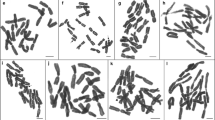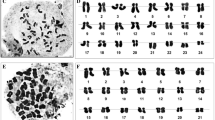Abstract
The frequencies and behaviour of two types of accessory chromosome in Brachycome lineariloba species A (n=2) are reported. These include a larger (ca. 4.0 μ macro-B chromosome, and a minute (<1.0 μ) micro-B. Twelve per-cent of the 452 plants studied were carriers of one, two or more rarely three macro-B chromosomes. These were usually mitotically stable, but showed some meiotic irregularity when present in odd number. An equilibrium situation is inferred, and loss must be balanced against mechanisms tending to increase B frequency. A surplus of plants with two B chromosomes also suggests that mechanisms of doubling may operate. A possible source of the macro-B's is considered to be hybridisation between the several species of the B. lineariloba complex. — The micro-B chromosomes were found in 3.8% of two only of the three known cytological races of the species. They showed extreme irregularity in both mitotic and meiotic behaviour. Their relationship to the normal (A) chromosomes and to the macro-B's is obscure.
Similar content being viewed by others
References
Battaglia, E.: Cytogenetics of B-chromosomes. Caryologia (Firenze) 17, 245–299 (1964).
Bradley, M. V.: Acetocarmine squash techniques for mature embryo sacs. Stain Technol. 23, 29–40 (1958).
Cleland, R. E.: Further evidence bearing upon the origin of extra diminutive chromosomes in Oenothera hookeri. Evolution (Lawrence, Kans.) 21, 341–344 (1967).
Darlington, C. D.: Chromosome botany. London: G. Allen and Unwin (1956).
Davis, G. L.: A revision of the genus Brachycome. Proc. Linn. Soc., N. S. Wales 73, 142–241 (1948).
Fröst, S.: Numerical increase of accessory chromosomes in Crepis conyzaefolia. Hereditas (Lund) 48, 667–676 (1962).
Jackson, R. C.: Supernumerary chromosomes in Haplopappus gracilis. Evolution (Lancaster, Pa.) 14, 135 (1960).
Jackson, R. C.: Interspecific hybridisation in Haplopappus and its bearing on evolution in the Blepharodon section. Amer. J. Bot. 49, 119–132 (1962).
John, B., Hewitt, G. M.: The B chromosome system of Myrmeleotettix maculatus (Thunb). II. The statics. Chromosoma (Berl.) 17, 121–138 (1965).
Jones, R. N., Rees, H.: Genotypic control of chromosome behaviour in rye. XI. The influence of B chromosomes on meiosis. Heredity 22, 333–347 (1967).
Kayano, H.: Cytogenetic studies in Lilium callosum. III. Preferential segregation of a supernumerary chromosome in EMCs. Proc. Jap. Acad. 33, 553–558 (1957).
Kimura, M., Kayano, H.: The maintenance of supernumerary chromosomes in wild populations of Lilium callosum by preferential segregation. Genetics 46, 1699–1712 (1961).
Li, C. C.: Population genetics. Chicago: Chicago University Press (1955).
Matsuda, T.: On the accessory chromosomes of Aster. I. The accessory chromosomes of Aster ageratoides group. J. Sci. Hiroshima Univ., Ser. B. Div. 2, 13, 1–63 (1970)a).
Matsuda, T.: On the accessory chromosomes of Aster. III. The accessory chromosomes of Aster scaber. J. Sci. Hiroshima Univ., Ser. B. Div. 2. 13, 81–90 (1970)b).
Newcomer, E. H.: A new cytological and histological fixing fluid. Science 118, 161 (1953).
Östergren, G.: Parasitic nature of extra fragment chromosomes. Bot. Notiser 1945, 157–163.
Smith-White, S.: Brachycome lineariloba. A species for experimental cytogenetics. Chromosoma (Berl.) 23, 359–364 (1968).
Smith-White, S., Carter, C. R.: The cytology of Brachycome lineariloba. 2. The chromosome species and their relationships. Chromosoma (Berl.) 30, 129–153 (1970).
Smith-White, S., Carter, C. R., Stace, H. M.: The cytology of Brachycome. Aust. J. Bot. 18, 99–125 (1970).
Stebbins, G. L.: Longevity, habitat and release of genetic variability in higher plants. Cold. Spr. Harb. Symp. quant. Biol. 23, 365–378 (1958).
Author information
Authors and Affiliations
Rights and permissions
About this article
Cite this article
Carter, C.R., Smith-White, S. The cytology of Brachycome lineariloba . Chromosoma 39, 361–379 (1972). https://doi.org/10.1007/BF00326173
Received:
Issue Date:
DOI: https://doi.org/10.1007/BF00326173




